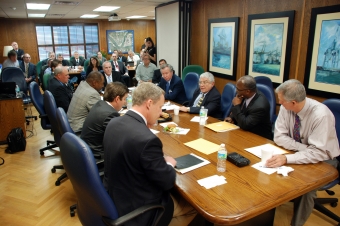Summary:
It is an activity that focuses on the writing of contractual clauses to resolve issues identified in the context of a contractual relationship. It is intended that students draw up contractual clauses which best realized for these solutions. For that, they are faced with difficulties that arose in the context of a gas supply deal between Petrobras and Bolivia, then they must create alternatives to renegotiate the supply agreement between Petrobras and YPFB and the Transport Agreement related to that. The dynamics was applied after the "Petrobras case - Supply Contracts and Transportation and clauses of take-or-pay, ship-or-pay" dynamics.
Objective:
- GENERAL GOALS: they should understand the possibility and the limits of the parties defined the applicable regulatory regime in the face of changing circumstances in long-term contracts;
- SPECIFIC GOALS: they will write clauses to guide or to structure the future renegotiation of the supply agreement between Petrobras and YPFB and the Transport Agreement. - It is intended that students are able to:
1) Articulate the strategies solution to change the regulatory framework in time
2) Write clauses that best realized these solutions.
Dynamics:
- MÉTODO DE ENSINO: o Problem-Based Learning (PBL), no qual os alunos são confrontados com um problema concreto ao qual devem dar uma solução;
- PREPARAÇÃO: Houve leitura prévia do caso Petrobrás.
- INTRODUÇÃO
- TEACHING METHOD: Problem-Based Learning (PBL), in which students are faced with a real problem to which they should give a solution; - REQUIREMENTS: There was a previous reading about the Petrobras case.
- INTRODUCTION OF THE DYNAMICS: At the beginning of the class, in 15 to 20 minutes, the professor made a brief introduction of the problem, questioning students about the facts read previously.
- DEVELOPMENT OF THE DYNAMICS: After identifying the problem, the professor divided the students into three groups of five students formed freely. It was up to the students, discuss about the problem and produce a document that aims at guiding (opinion) and/or structure (clause writing) the contractual renegotiation of the supply agreement between Petrobras and YPFB and the contract related to transportation. This moment of group discussions and writing of the contractual clause took around 1 hour. The professor circulated among them to clear and universalize any doubt.
- END OF THE DYNAMICS: The professor made a 10-minute closure to indicate the sensitive points of the problem, pointing out the essential elements that should appear in the document of the students. They had another 10 minutes to complete the writing of the clause and deliver to the professor.
- ATTENTION IN THE CLASSROOM: 1) During the development of the activities, it was noted that the language was an important element and that whole contracts were long, two difficulties that were mitigated by the use of computers and the internet. The computer use, however, make difficult the topological view of the contract. It is recommended that professor make this alert;
2) The students should use the narrative data to understand the concrete facts and the operation of the contracts;
3) It is recommended that the professor help the students in time the management;
4) It is recommended the professor encourages the students to structure the document in view of the correction criteria.
Evaluation:
- FEEDBACK: The professor made comments and controlled the writing of the clauses during the group work. He commented on the terms drawn up by the groups in a collective discussion. Additionally, he delivered the final products with commentary for groups.
- GRADE EVALUATION: Evaluation of the document. Criteria: clarity, synthesis and conceptual rigor. Also, the adherence to the problem and the adaptation to the legal system were evaluated.
Observation:
1) The professor can present the problem to be discussed in class (ex.: contract renegotiation), but can also ask questions about the contract in the light of the text read, waiting for students to identify the main problem (ex.: change of the Bolivian policy on hydrocarbons and how it influenced the contract);
2) This activity can be used with various other problems. It was applied, as an example to discuss stabilization of contract clauses. The discussion about writing the stabilization clause can be used to address the discussion on mediation, transaction and arbitration in contracts. There are connections between the clauses displace the jurisdiction (who decides?) and the clauses that define the applicable standards (based on who decides?).
3) If the activity "Petrobras Case - Supply Contracts and Transportation and clauses take-or-pay and ship-or-pay" was previously used it is suggested the replacement of obligated reading indicated on the card with a text on the content. In the event that only use this activity, it is suggested the reading indication complementary to the case of texts about the subject. Another option is the production, by the professor, of a small text on the provisions subject to the exercise as a complementary to obligated reading.
4) At the beginning of the following class the professor can bring the relationship of case with another one, and comment on the responses produced in the previous class.
Copyright from the cover page image:
Image: Entardecer em Porto Trombetas, available at Wikimedia Commons, author: Carolina Teixeira de Melo Franco, under the Creative Commons BY-SA 3.0 license.






